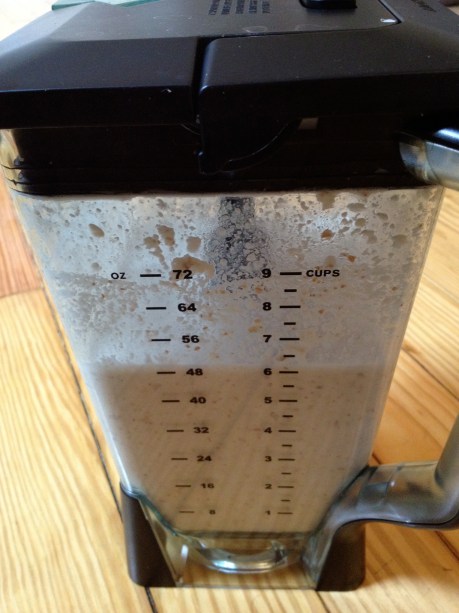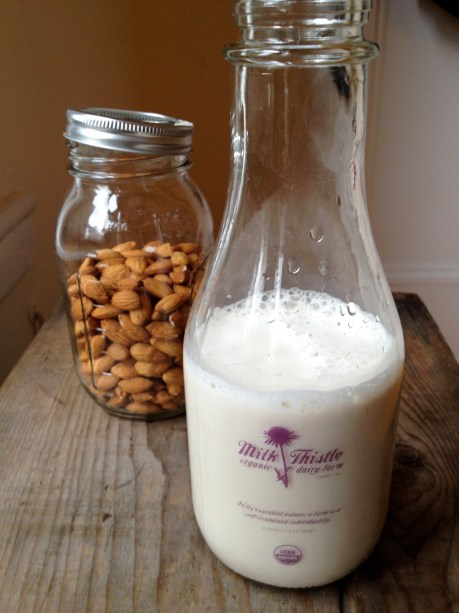So I was at my happy place yesterday afternoon (the PSFC, which you should know by now is the Park Slope Food Cult), slicing a wheel of Humboldt Fog, bantering with my fellow workers about topics ranging from: if the quality of red meat continues to improve with grass-fed beef and small farmers, will overall meat consumption rise? How to make french toast with tofu instead of bread (tell ya later). And using Tuesday’s general meeting on the Israeli boycott as a venue for one’s performance art. In other words, we were a parody of ourselves, what Samantha Bee called “a diverse group of NPR listeners.” (If you haven’t seen the Daily Show clip on the co-op, click here.)
My little crew of Week-A Friday food processing workers is a delightful bunch of folks including the NYC Bikram Yoga champion; a journalist exposing a cover-up at Fukushima; an event planner organizing a 1,500-person NYC Easter egg hunt next weekend; a midwife; writing professor; and metal-worker jewelry designer. We come together once every four weeks to wrap cheese, package dried mango, and debate things like the Pfizer birth control recall and the best new burger joint in the Slope, for precisely 2 hours and 45 minutes.
We started talking about almond milk and one woman mentioned making her own. I’ve been wanting to try this since I go through about a quart a week and, well, generally prefer making to buying. She told me her method, I committed it to memory, and after our shift I bought about one pound of raw, unsalted almonds, the only ingredient you really need. This is the easiest thing I’ve made for this blog yet (except maybe for one of my first posts, last April, on Vermont Iced Coffee.)
The benefits of homemade almond milk are more about flavor than cost effectiveness. In fact it may even cost more to make it yourself, even when buying from the co-op’s bulk bins, but not much. The price I paid was $4.21 per pound (for organic), and you need about 1 pound of almonds to yield one quart of almond milk, whereas buying a pre-made quart is usually $2 to $3. But the flavor is incomparable. This homemade stuff is rich, creamy, not watery, with a very distinct almond flavor. Buy your almonds from a place with high turnover. Nuts go rancid rather quickly; they should be as fresh as possible, I wouldn’t really bother with stale almonds. The resulting flavor is so good, and texture so smooth, I will definitely finish this quart before next week.
One more thing, in order to do this, you need a powerful blender, preferably one with at least 1,000 watts of power. A VitaMix is ideal, although expensive I know (but such a good investment); I use the Ninja blender I got a few months ago, which makes amazing green smoothies and blends everything from ice to vegetables in seconds.
You can adjust the amount of water in the recipe below depending on how thick you’d like the results. These proportions will give you a creamy-ish milk but not all that thick. Get blending!
Homemade Almond Milk
1 pound (about 3 cups) raw, unsalted almonds
3 cups water (for soaking) plus 2 more cups
a few drops of vanilla extract
tiny pinch of salt (optional)
Place the almonds in a bowl or pot and add the 3 cups of water. Cover with a lid, and let soak for at least 12 hours.
Place the almonds and their soaking liquid in a blender and blend until creamy. Halfway through blending, add the vanilla and about 2 more cups of water, gradually. This will take anywhere between, say, one and two minutes depending on your blender.
Line a large bowl with cheesecloth (or, I used a reusable cloth produce bag) and place the contents of the blender (liquid, almond pulp, and all) into the cheesecloth or bag, over the bowl. Strain the mixture into the bowl, squeezing all the liquid out. You’ll be left with quite a bit of almond pulp – I’m taking suggestions on what to do with this since it seems like a shame to just throw out.
Ode to Milk Thistle Farm – paying tribute by using their old glass bottle to store my almond milk. (I mention here how they sadly went out of business recently.)





Looks great Holly! Are you on twitter? We just gave the post a tweet, but didn’t know your handle to tag you.
Cheers!
Jason
One of the @CypressGrovers
Wow, thank you Jason! I adore your cheeses and really appreciate the tweet. I don’t have a twitter handle (yet). Highlight of my coop shift is always slicing the Humboldt Fog…
[…] HomeAbout Mostly Food A site about culinary (mis)adventures « Delicious, Easy, Homemade Almond Milk (Organic too!) […]
[…] yogurt is almost foolproof. Like making ricotta or almond milk or tempeh. (Ok, making tempeh isn’t really easy at all but you should read this post by […]
[…] 1/3 cup almond milk (recipe for homemade version here) 2/3 cup coconut milk 1 tsp vanilla extract 1/2 tsp cinnamon 2 tbsp maple syrup, more to taste 1/2 […]